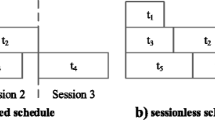Abstract
Increasingly, test generation algorithms are being developed with the continuous creations of incredibly sophisticated computing systems. Of all the developments of testable as well as reliable designs for computing systems, the test generation for sequential circuits is usually viewed as one of the hard nuts to be solved for its complexity and time-consuming issue. Although dozens of algorithms have been proposed to cope with this issue, it still remains much to be desired in solving such problems as to determine
-
1)
which of the existing test generation algorithms could be the most efficient for some particular circuits (by efficiency, we mean the Fault Coverage the algorithm offers, CPU time when executing, the number of test patterns to be applied, etc.) since different algorithms would be preferable for different circuits;
-
2)
which parameters (such as the number of gates, flip-flops and loops, etc., in the circuit) will have the most or least influences on test generation so that the designers of circuits can have a global understanding during the stage of designing for testability.
Testability forecasting methodology for the sequential circuits using regression models is presented which a user usually needs for analyzing his own circuits and selecting the most suitable test generation algorithm from all possible algorithms available. Some examples and experiment results are also provided in order to show how helpful and practical the method is.
Similar content being viewed by others
References
Prathima Agrawal, Vishwani D Agrawal, Joan Villodo. Sequential circuit test generation on a distributed system. InProc. 30th ACM/IEEE Design Automation Conf., pp. 107–111, 1993.
Elisabeth Auth, Michael H Schulz. A test-pattern-generation algorithm for sequential circuits.IEEE Trans. Design and Test of Computers, 1991, (6): 72–85.
Michael H Schulz, Elisabeth Auth. ESSENTIAL: An efficient self-learning test pattern generation algorithm for sequential circuits. InProc. IEEE Int’l Test Conf., pp 28–37, 1989.
Debashis Bhattacharya, Parthima Agrawal, Agrawal V D. Delay fault test generation for scan/hold circuits using Boolean expressions. InProc. 29th ACM/IEEE Design Automation. Conf., pp.159–164, 1992.
Franc Brglez, David Bryan, Krzysztof Kozminski. Combinational profiles of sequential benchmark circuits. InProc. IEEE Int’l Symp. Circuits and Syst., pp.1929–1934, May 1989.
Ted Stanion, Debashis Bhattacharya. TSUNAMI: A path oriented scheme for algebric test generation. InProc. IEEE 21st Symp. on Fault-Tol. Comp., pp.36–43, June 1991.
Srimat T Chakradhar, Vishwani D Agrawal, Steven G Rothweiler. A transitive closure algorithm for test generation.IEEE Trans. Computer-Aided Design of Integrated Circuits And Systems, 1993, 12(7): 1015–1028.
Cheng Wutung, Tapan J Chakraborty. Gen Test—An automatic test generation system for sequential circuits.IEEE Trans. Computers, 1989, (4): 43–49.
Hyunwoo Cho, Gray D. Hachtel, Fabio Somenzi. Redundancy identification/removal and test generation for sequential circuits using implicit enumeration.IEEE Trans. Computer-Aided Design of Integrated Circuits and Systems, 1993, 12(7): 935–945.
Jwe E. Chen, Chung Len Lee. Single-fault collapsing analysis in sequential logic circuits. InProc. IEEE Int’l Test Conf., pp.809–814, 1990.
Dias G. Percy, Xu Shiyi. Important testability parameters of sequential circuit. InProc. Computer Testing Workshop of China, pp.7–11, July 1994.
Fujiwara H, Shimono T. On the acceleration of test generation algorithms.IEEE Trans. Computers, 1983, C-32(12): 1137–1144.
Abhyijit Ghosh, Srinivas Devadas, Richard Newtion. Test generation and verification for highly sequential circuits.IEEE Trans. Computer-Aided Design, 1991, 10(5): 652–667.
Hatayama K, Hikone K, Ikeda M,. Hayashi T. Sequential test generation based on real-valued logic simulation. InProc. IEEE Int. Test Conf., pp.41–48, Sept. 1992.
Hayashi T, Hatayama K, Ishiyama S, Takakura M. Two test generation methods for sequential circuits. InProc. IEEE Int’l Symp. Circuits and System, pp.1942–1945, May 1989.
Kundu S, Huisman L M, Nair I, Iyengar V, Reddy L. A small test generation for large designs. InProc. IEEE Int’l Test Conf., pp.30–40, 1992.
Kleinbaum D, Kupper L L. Applied Regression Analysis and Other Multivariable Methods. PWS Pub., Duxbury Press, pp. 131–144. 1978.
Kelsey T P, Saluja K K, Lee S Y. An efficient algorithm for sequential circuit test generation.IEEE Trans. Computers, 1993, 42(11): 1361–1371.
Lee D H, Reddy S M. A new test generation method for sequential circuits. InACM/IEEE Int’l Conf., Computer-Aided Design, pp.446–449, Nov. 1991.
Lee S Y, Saluja K K. An algorithm to reduce test application time in full scan designs. InACM/IEEE Int’l Conf. Computer-Aided Design, pp.7–20, Nov. 1992.
Author information
Authors and Affiliations
Additional information
This work was supported by National Natural Science Foundation of China (NSFC) under the grant No. 69073333.
Xu Shiyi graduated from the Department of Mathematics of Fudan University, Shanghai in 1964. During 1980–1983 and 1990–1991, he was a visiting scholar in the department od Computer Science of the State University of New York at Binghamton, New York, and Colorado State University, Colorado, USA, respectively. Since 1964, he has been working with the Shanghai University of Science and Technology where he is currently a Professor. He is now a steering committee member of IEEE Pacific Rim Fault Tolerant Systems, a steering committee member of IEEE Asia Test Technology Technical Committee and a Vice Chair of the Technical Committee of Fault Tolerant Computing under the Computer Federation of China. His research interests include VLSI testing, fault tolerant computing, reliable design and switching theory. He has published 50 papers and two books (in Chinese).
Garvin Percy Dias obtained B.S. from University of Sri Jayawardenepura, Sri Lanka, in 1990, and his M.S. Degree in computer science from Shanghai University of Science and Technology, China in 1995, respectively. He was a Lecturer in computer science at the Open University of Sri Lanka. Currently, he is a Ph.D. candidate at the Department of Computer Science and Technology, Fudan University. His researcg interests are fault tolerant computing, testing, data base and statistics mathematics. He has, up to now, four papers.
Rights and permissions
About this article
Cite this article
Xu, S., Dias, G.P. The methodology of testability prediction for sequential circuits. J. of Comput. Sci. & Technol. 11, 529–541 (1996). https://doi.org/10.1007/BF02951616
Received:
Revised:
Issue Date:
DOI: https://doi.org/10.1007/BF02951616




